If you’ve taken a moment to watch the insect activity in your yard, you’ll know that bees are some of the most hardworking creatures you can find.
Their industrious activity keeps 90% of wild plants and over 75% of crops pollinated, contributing to at least one in every 4 mouthfuls of food that we eat!
Bees are not just the cute furry critters that live in hives and produce honey.
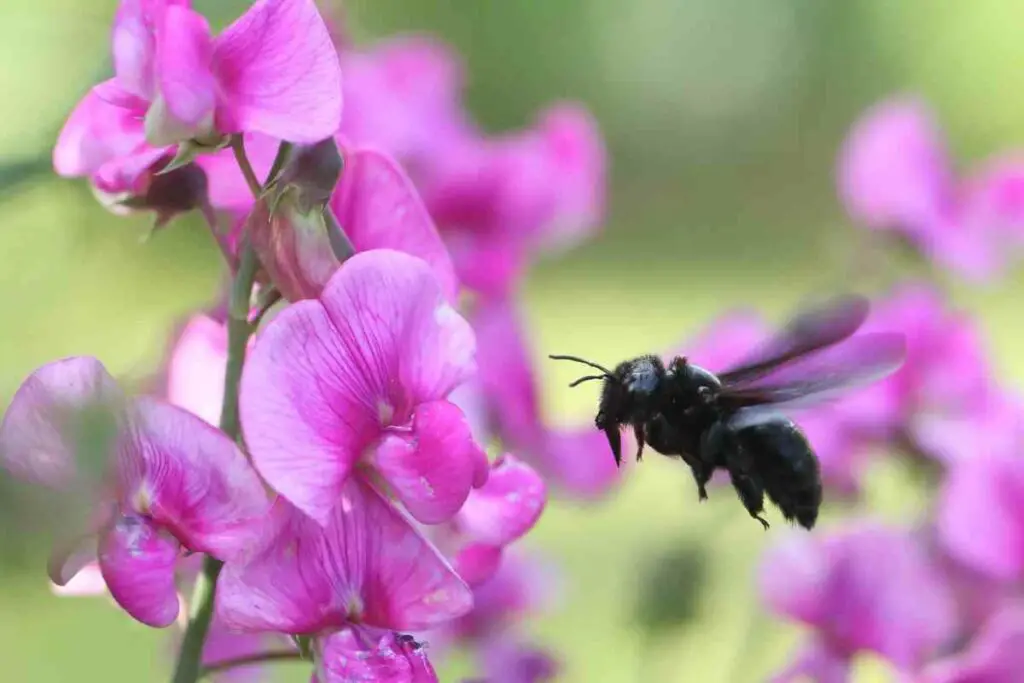
They are amazingly diverse with over 20,000 bee species in the world, with 4000 native bee species in North America alone.
In fact, it is highly likely that you are missing out on spotting many of the fascinating bee species around you, mistaking them for wasps, flies, and other bugs.
What to Expect? If you would like to tell apart the different types of bees, we’re here to help with a complete guide to the most common bee species, including their shapes, colors, and the time of year you’ll see them out and about.
Let’s get bee spotting!
A quick guide to easy bee identification
You don’t have to be an entomologist to identify bees in your yard.
Once you have some basic rules for spotting bees, you’ll be blown away by just how many there are around you.
Here are the key areas to look out for when identifying bees.
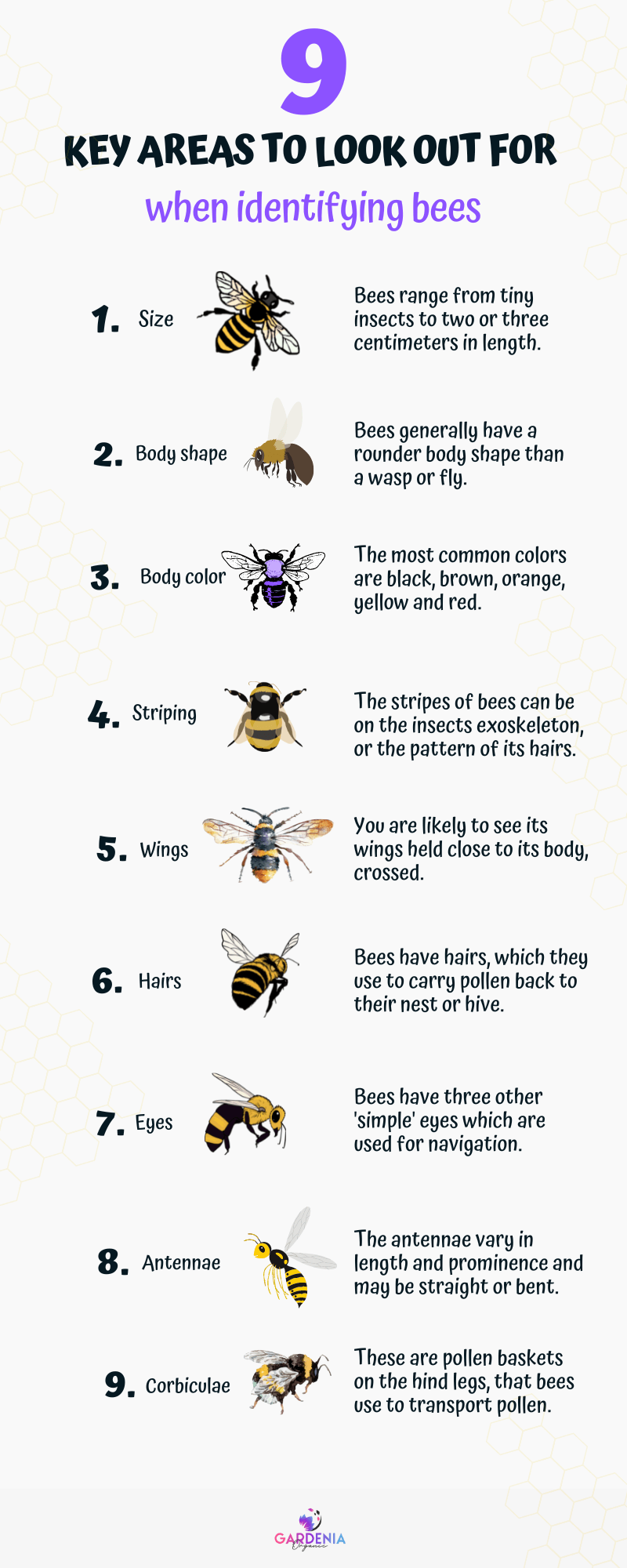
Size
Bees range from tiny insects with a body length of under a centimeter to large, armored juggernauts of two or three centimeters in length.
- Tiny bees are usually less than 10 mm in length
- Small bees are usually 10-15mm in length
- Medium bees are usually 15-20mm in length
- Large bees usually have a length of 20mm or more
The world’s largest bee, the Himalayan giant honeybee, is particularly aggressive with a sting to match!
Body shape
Bees generally have a rounder body shape than a wasp or fly.
The different bee families have specific body shapes that can help you easily identify them.
The main body shapes are:
- Apiform (common in honeybees)
- Bombiform (common in bumblebees)
- Megachiliform (common in mason bees)
- Euceriform
- Andreniform
- Hylaeiform
Body color
Bees come in a kaleidoscope of colors including metallic blues, greens and purples.
The most common colors are black, brown, orange, yellow and red.
Striping
The stripes of bees can be on the insects exoskeleton, or the pattern of its hairs. Look for bands of black, brown, white, buff, yellow, orange, and red.
Wings
Bees have four wings; two pairs with smaller hind-wings.
If you get up close to a bee, you are likely to see its wings held close to its body, crossed, or at a 45-degree angle.
Hairs
Bees don’t have pockets, they have hairs, which they use to carry pollen back to their nest or hive.
Hairs are present on the head, body, underside of the abdomen and legs of bees.
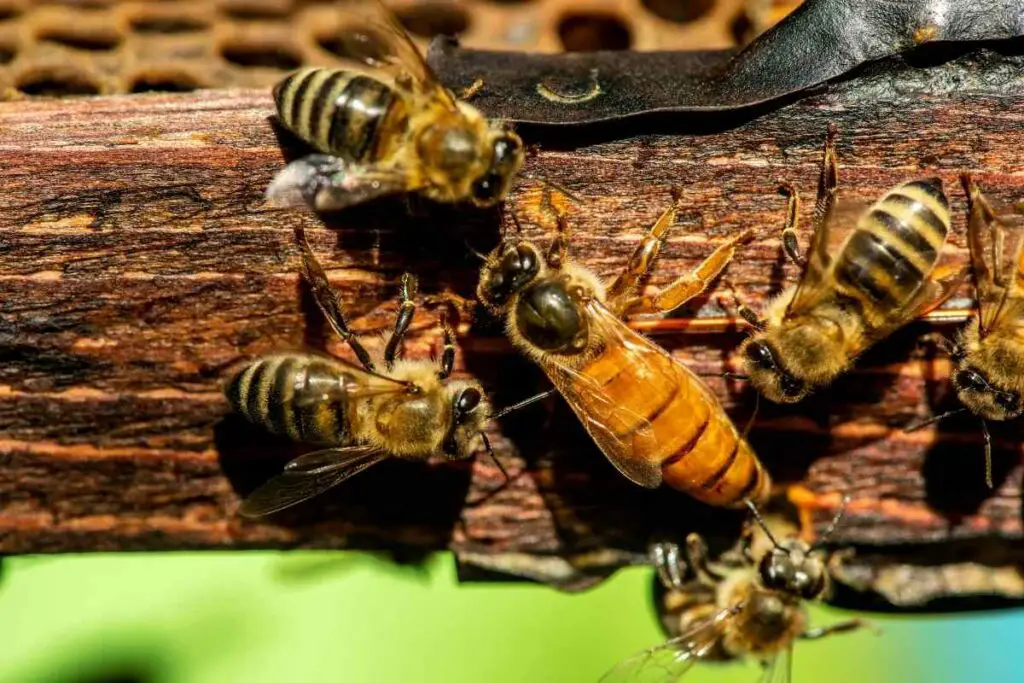
Some of these pollen-carrying hairs are known as scopae. As you’ll see below, you can spot specific types of bees by the presence, absence or color of its hairs.
Eyes
Bees have large, well-separated eyes.
These are known as compound eyes, which help the bees see shapes and objects.
Did You Know? Bees also have three other ‘simple’ eyes on their heads which are used for navigation and orientation.
Antennae
Like most insects, bees have antennae. The antennae vary in length and prominence and may be straight or bent.
Corbiculae
These are pollen baskets on the hind legs, that bees use to transport pollen.
Bumblebees and honeybees often have these prominent, flattened leg plates.
Easy bee identification guide
Here is a summary of the most common bee species in the world.
Use this list to identify bees in your backyard and learn more about the diversity of these amazing creatures.
HONEYBEES (Apis)
These are the eight recognized species of honey bees.
1. Western honey bee – Apis mellifera

- Time active: Spring to late fall
- Size: Medium (>10 mm)
- Body shape: Apiform body shape – slender but robust
Body color and pattern:
- Red/brown coloration with a dark abdomen with orange-yellow rings
- Hairy thorax and less hair on abdomen
- Prominent pollen baskets on dark hind legs
Additional points:
- Most common honeybee worldwide
- Prevalent in Europe, the Americas, and Africa
- Domesticated for widespread honey production
2. Black dwarf honey bee – Apis andreniformis
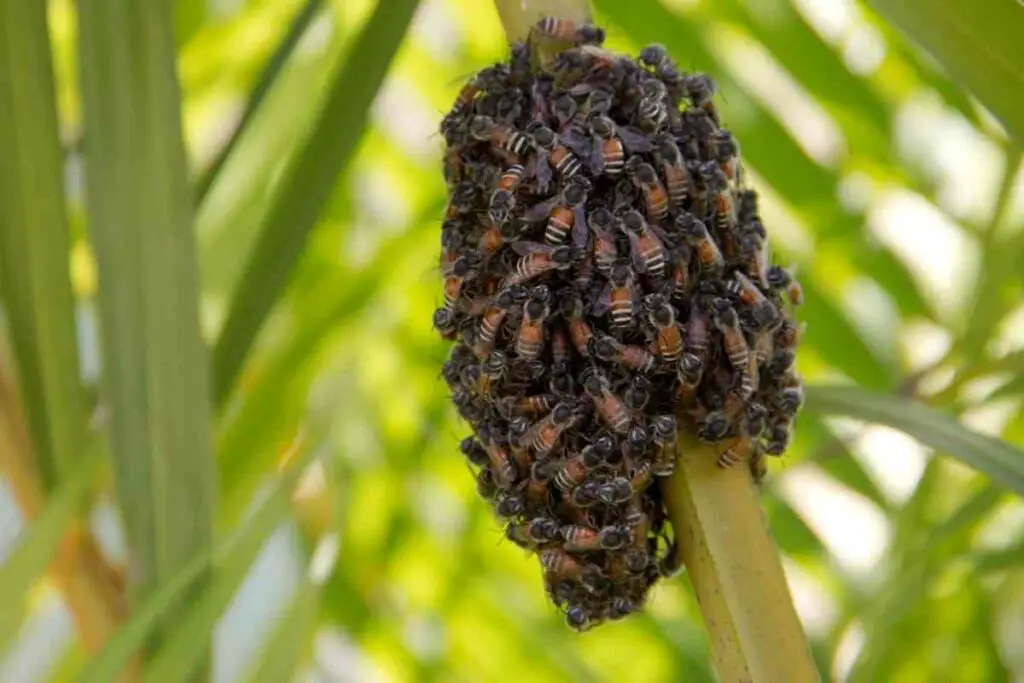
- Time active: December to June
- Size: Tiny (under 10 mm)
- Body shape: Andreniform small slender body
Body color and pattern:
- First two abdominal segments are dark
- Mustard yellow/reddish brown thorax
- Queens are entirely black
Additional points:
- Dwarf honeybee species from the tropics of Southeast Asia
- Primitive species with small colonies and open, single comb nests
3. Red dwarf honey bee – Apis florea
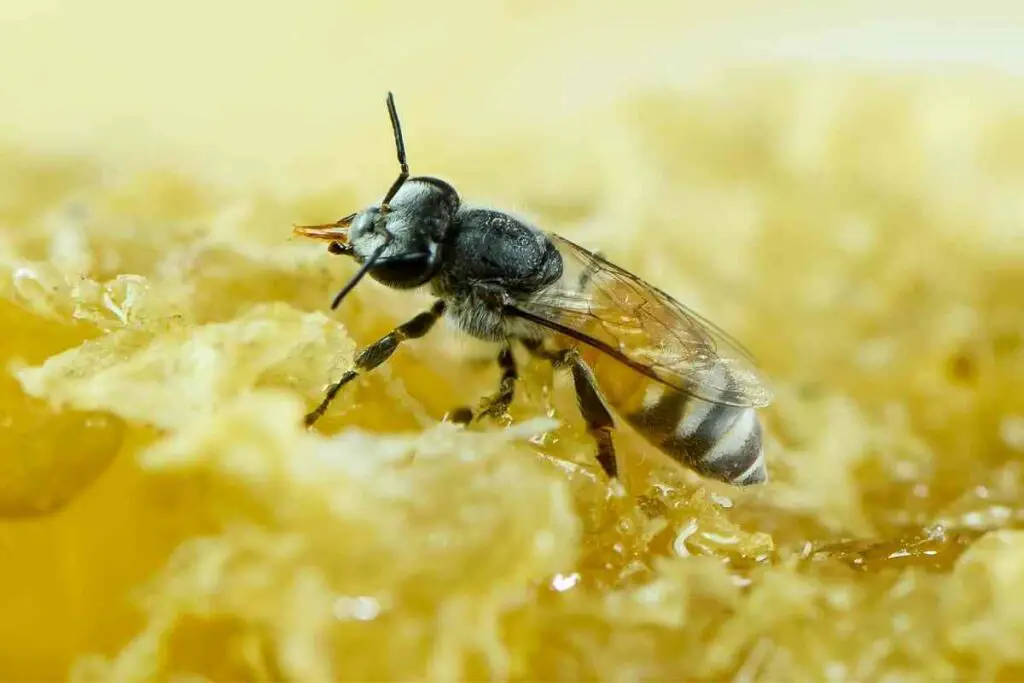
- Time active: Spring and summer
- Size: Tiny (under 10 mm)
- Body shape: Apiform body shape – slender but robust
Body color and pattern:
- Red-brown coloration with some black and white banding.
Additional points:
- Dwarf honeybee species from the tropics of Southeast Asia
- Smaller than other honeybee species. Colony assembles on a single exposed comb attached to a branch
- Tendency to nest near human settlements
- The sting is so small it may not be able to penetrate human skin
4. Eastern honey bee – Apis cerana
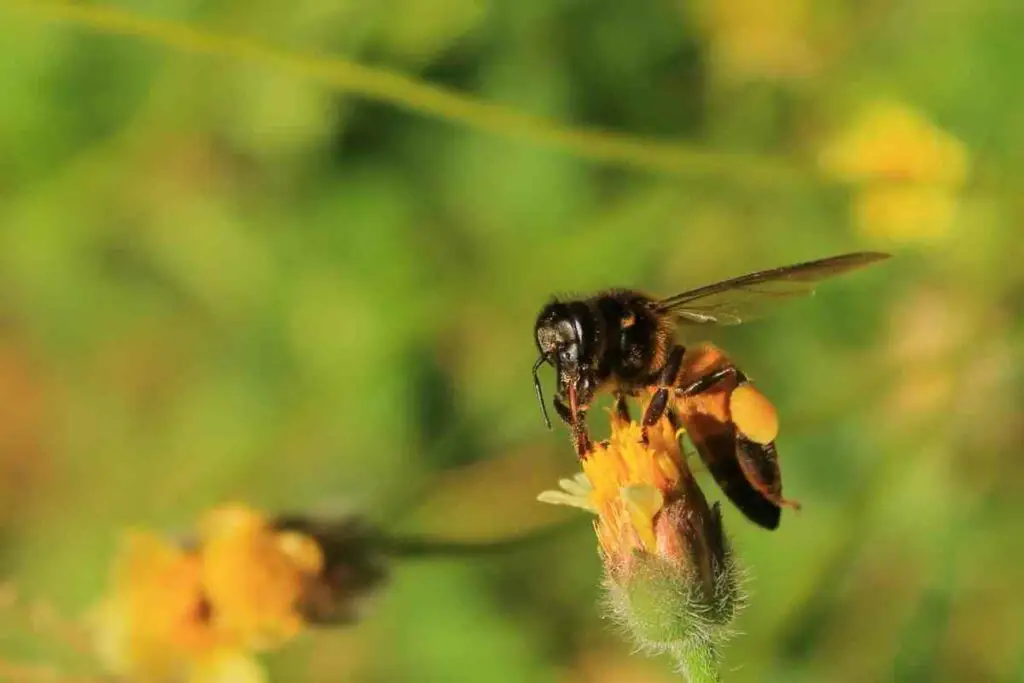
- Time active: Early summer through fall
- Size: Small (under 10mm)
- Body shape: Apiform body shape – slender but robust
Body color and pattern:
- Black coloration with four yellow stripes on the abdomen
- Rusty coloration on legs
Additional points:
- Asian honeybee species
- Diverse with numerous sub-species
- Body coloration varies with sex (Queens and fertile bees have deeper coloration)
5. Giant honey bee – Apis dorsata
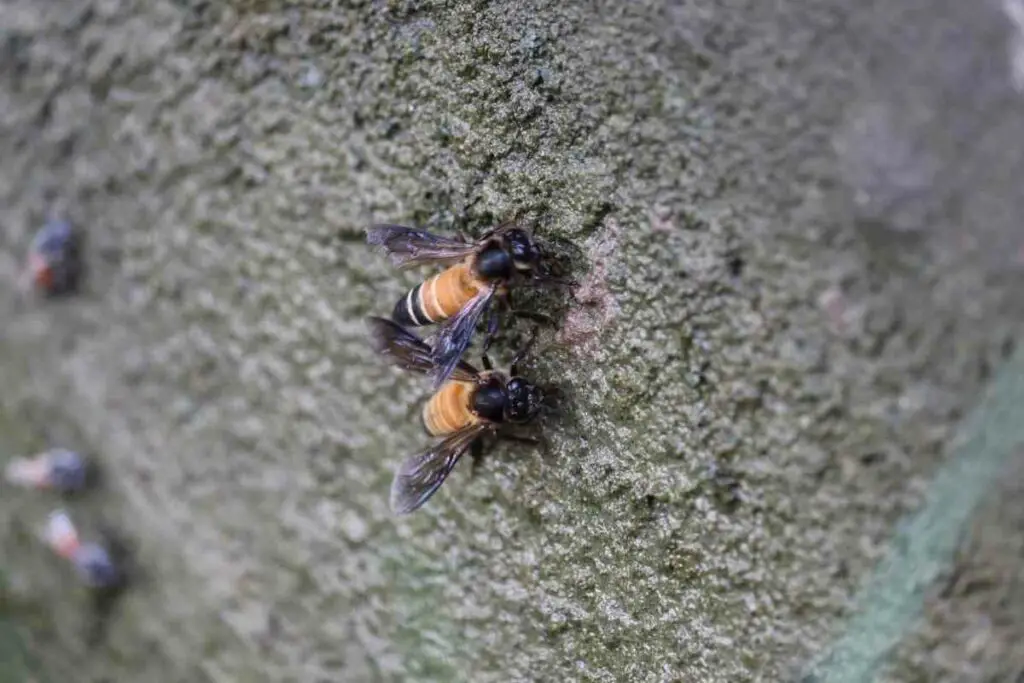
- Time active: December to September
- Size: Large (up to 20 mm)
- Body shape: Apiform body shape – large and elongated abdomen and hairy thorax
Body color and pattern:
- Variable coloration depending on subspecies – size is the key identifier
- Red-brown/brown-black scutellum, dark brown/black posterior with golden yellow or pale banding
Additional points:
- Southeast Asia honeybee species
- Nests in inaccessible locations (Colony assembles on a single exposed comb attached to a branch)
- Colonies can be extremely vicious if disturbed
6. Koschevnikov’s honey bee – Apis koschevnikovi

- Time active: Active season varies with elevation/local conditions
- Size: Medium (>10 mm)
- Body shape: Apiform body shape – stocky and robust
Body color and pattern:
- Dark brown or light orange banding
- Red color of the posterior part of the body (metasoma) and legs
Additional points:
- Found in the rainforests of Southeastern Asia- Nests in cavities
- Rare
7. Philippine honey bee – Apis nigrocincta
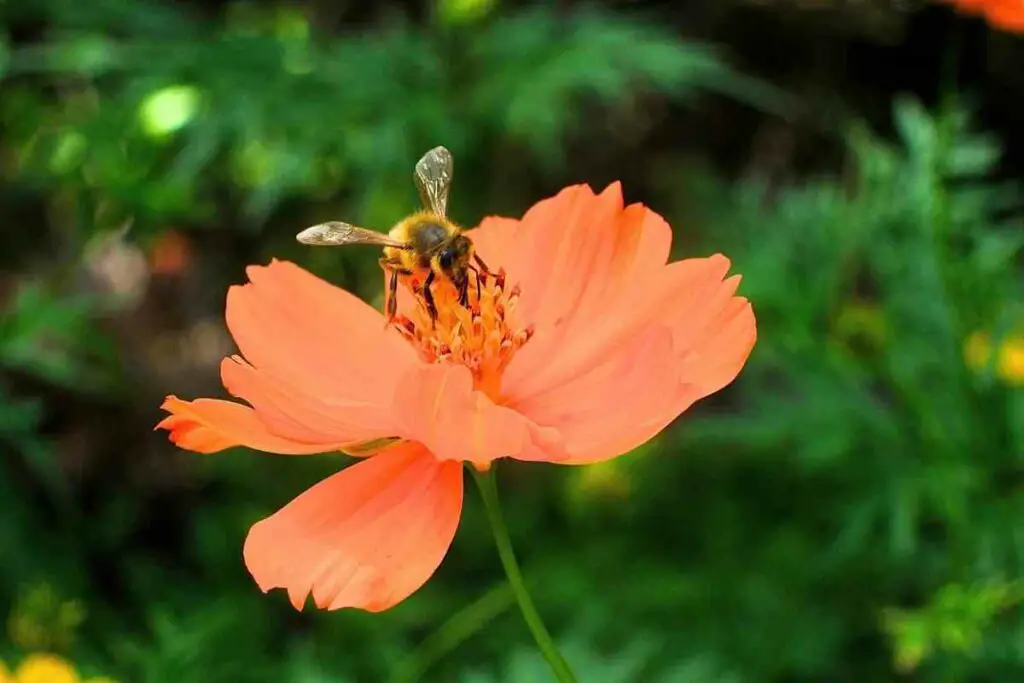
- Time active: Active season varies with elevation/local conditions
- Size: Medium (>10 mm)
- Body shape: Apiform body shape – stocky and robust
Body color and pattern:
- Yellow to rust-colored legs scapes and hairs
Additional points:
- Similar in appearance to Apis koschevnikovi
- A highly social, cavity-nesting bee from Indonesia and the Philippines. Instances of domestication in Indonesia
8. Himalayan giant honey bee – Apis laboriosa
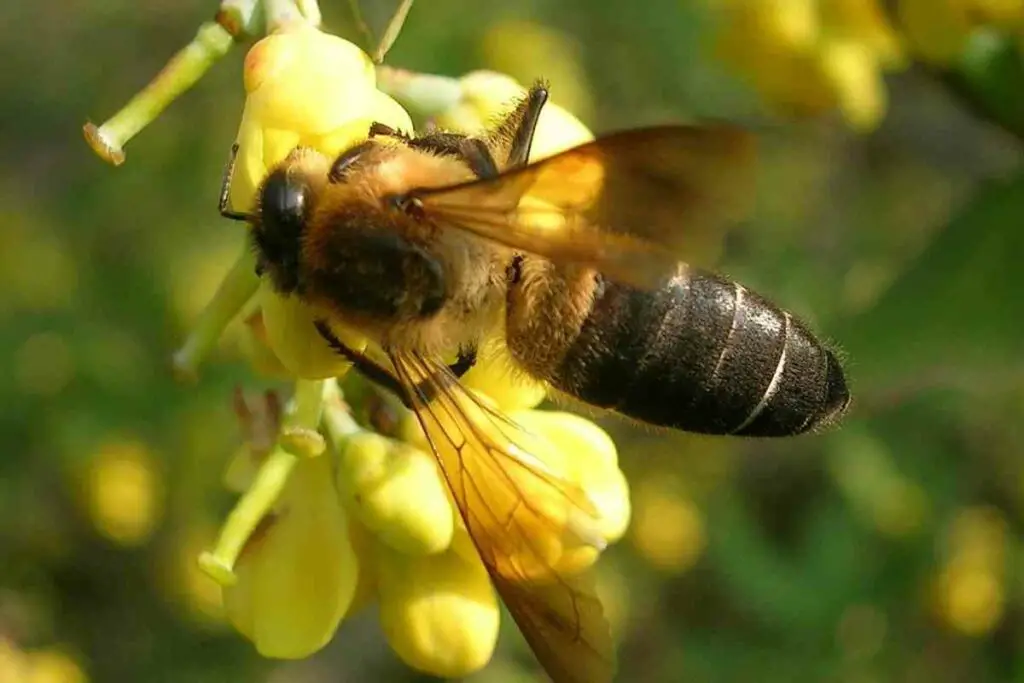
- Size: Large (up to 30 mm)
- Body shape: Apiform body shape – stocky and robust
Body color and pattern:
- The dorsal side of the thorax is dark brown to black with long yellowish hairs
- All segments of the abdomen are dark with pale banding
Additional points:
- The world’s largest honey bee
- Its honey is known as “red honey” or “mad honey”. It has hallucinogenic properties because it contains white rhododendron nectar
BUMBLEBEES (Apidae)
There are 250+ known species of bumblebee. Here are the most common types.
9. Buff-tailed bumblebee – Bombus terrestris
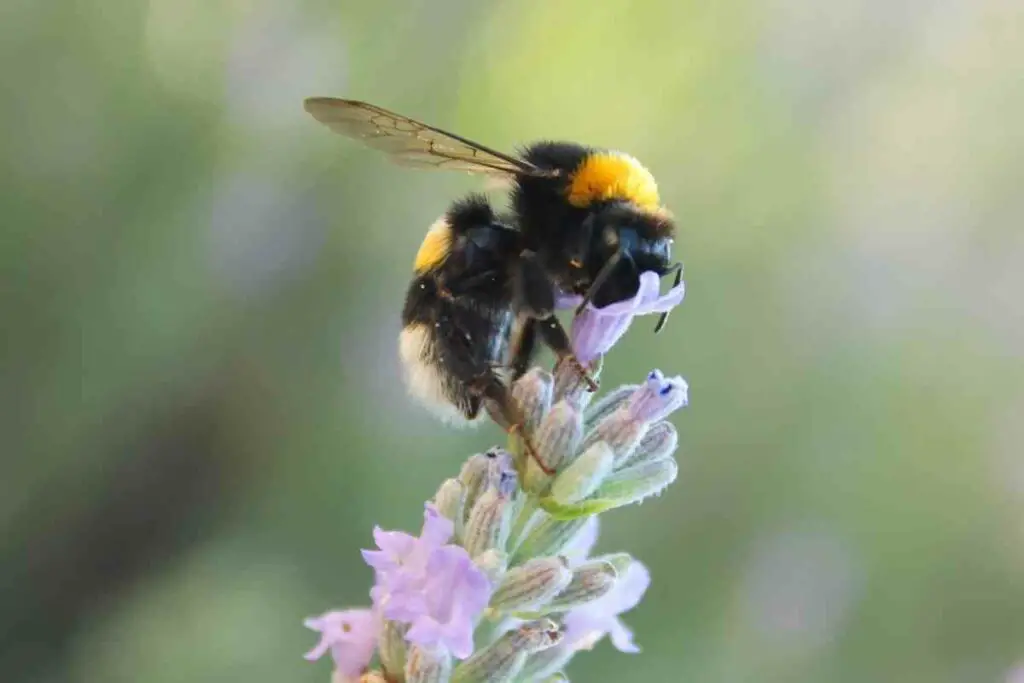
- Time active: Early spring through fall
- Size: Large (up to 17 mm)
- Body shape: Bombiform
Body color and pattern:
- Deep yellow bands over the thorax and mid-abdomen
- Only queens have a true buff-colored tail
- Workers have white tails with a faint buff line
Additional points:
- The largest bumblebee sub-species
- Earliest to emerge and visit gardens
10. Red-tailed bumble bee – Bombus lapidarius
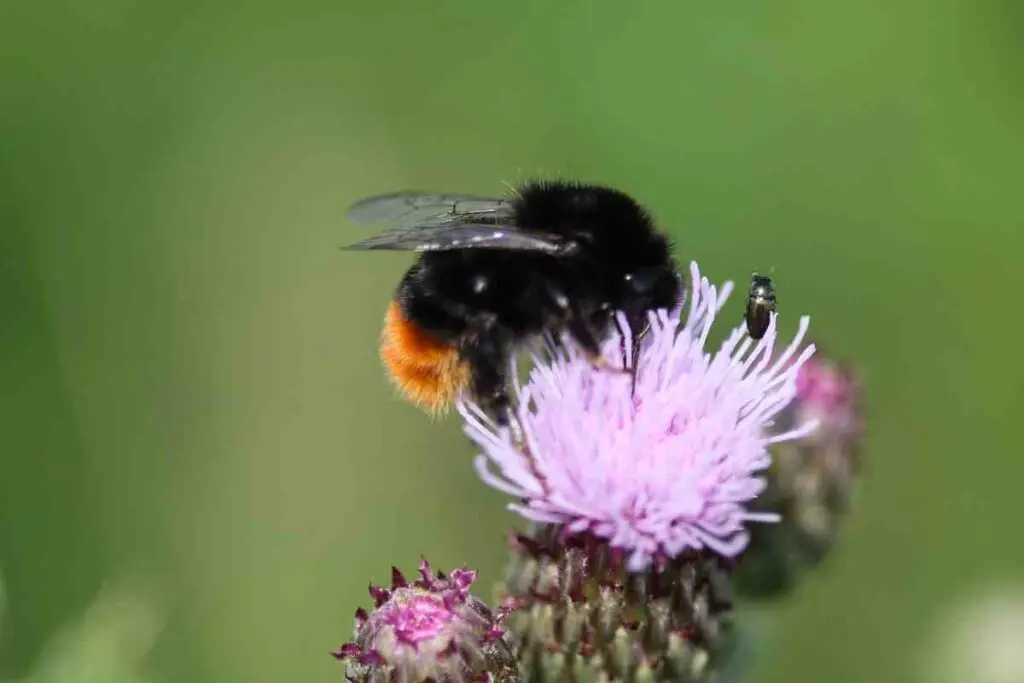
- Time active: Early spring through fall
- Size: Large (up to 17 mm)
- Body shape: Bombiform
Body color and pattern:
- Black with a bright red furry tail
- Red-orange tail color >50% of abdomen of queens
- Males also have yellow/pale hairs around their heads and the front/rear of their thorax
Additional points:
- This apidae subspecies looks similar too the Red-tailed cuckoo bumblebee (Bombus rupestris) and Red-shanked carder (Bombus ruderarius)
11. White-tailed bumblebee – Bombus lucorum

- Time active: Early spring through fall
- Size: Large (up to 17 mm)
- Body shape: Bombiform
Body color and pattern:
- Black with yellow bands and a bright white tail
- The Queen carries the characteristic markings
Additional points:
- Common foraging bee
- Queens are the only bumblebees that survive the winter
- Often hard to distinguish from the buff-tailed bumblebee
12. Common eastern bumblebee – Bombus impatiens
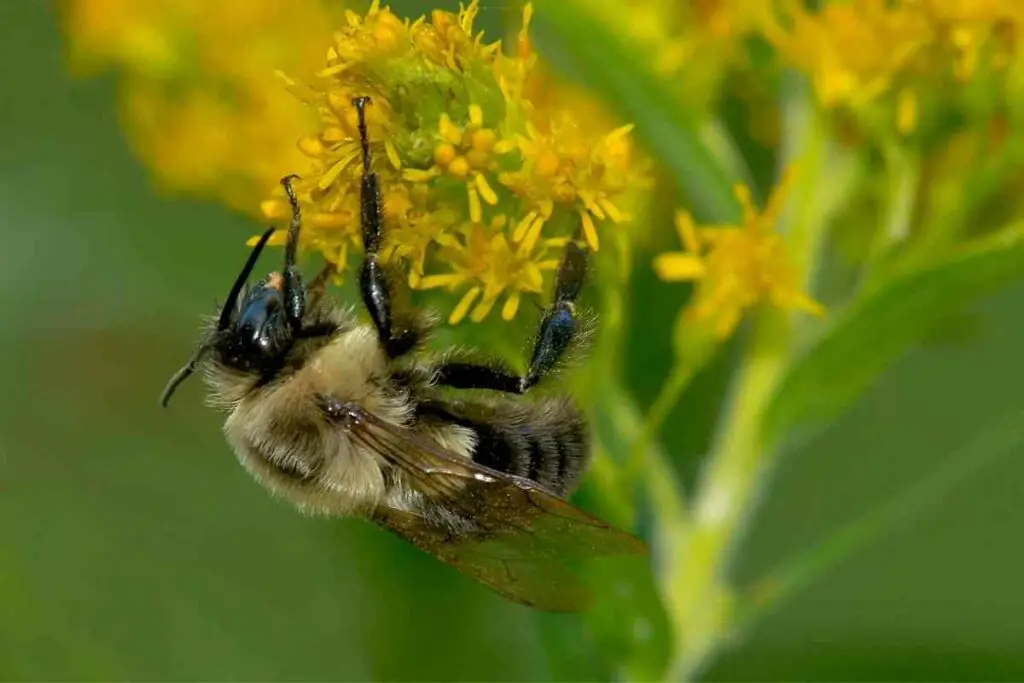
- Time active: April through fall
- Size: Large (up to 23 mm)
- Body shape: Bombiform
Body color and pattern:
- Black hairs on head, abdomen, and legs
- Shiny black bald spot at the center of its body
- Single yellow band at waist
Additional points:
- This is the most common bumblebee in North America
13. Cuckoo bumblebee – Bombus vestalis
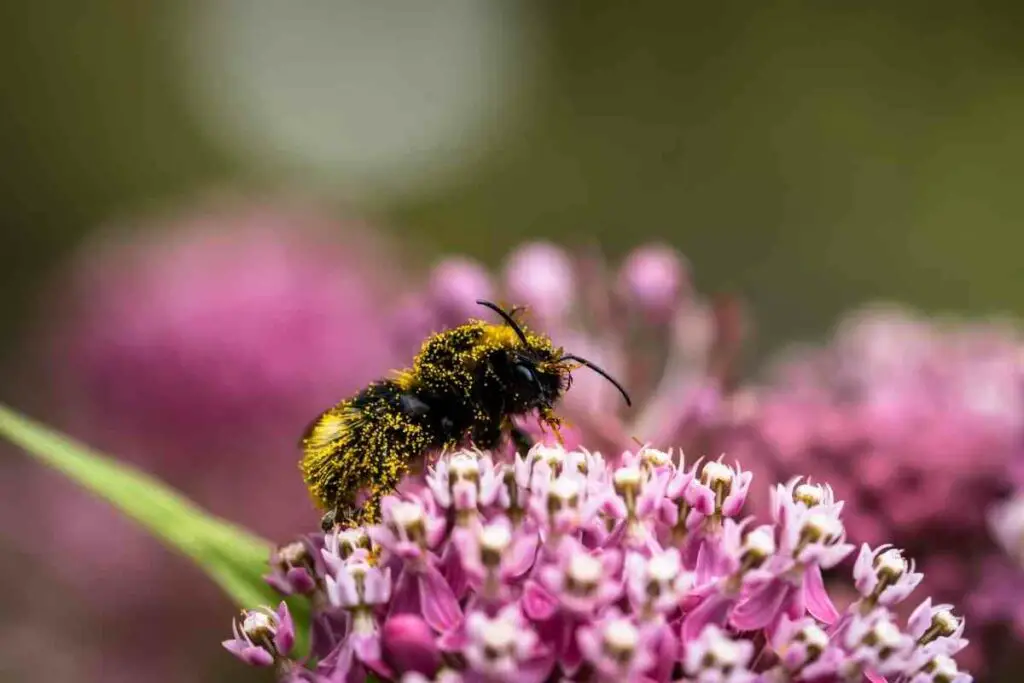
- Time active: March to May through fall
- Size: Large (up to 24 mm)
- Body shape: Bombiform (but more pointed abdomen)
Body color and pattern:
- Cuckoo bumblebee subspecies have a range of colors
- Common features include dark tinted wings, shiny thorax and abdomen, and, no pollen baskets on legs
Additional points:
- Species native to the UK and Northern Europe
- Like the cuckoo, it lays its eggs in the nest of another bumblebee species
- They mimic the hair color pattern of the species they target
14. Carder bumblebee – Bombus pascuorum
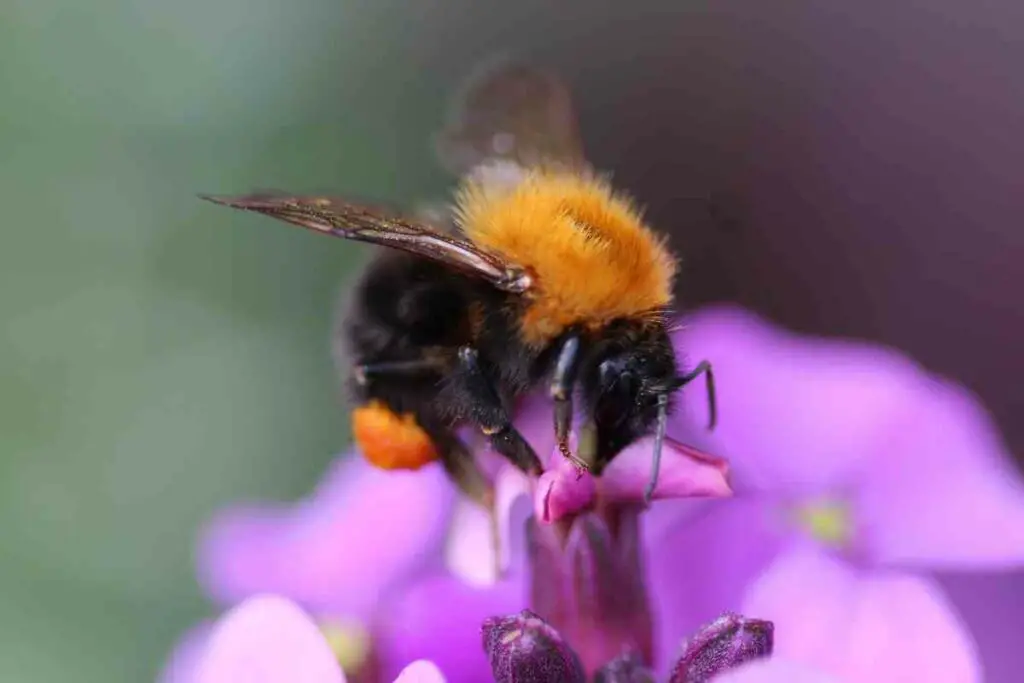
- Time active: Early spring through late fall
- Size: Medium-large (up to 15 mm)
- Body shape: Bombiform
Body color and pattern:
- Fluffy, orange-colored bumblebee with black hairs on the abdomen
Additional points:
- Males, workers, and queens have a similar appearance
- There are three all-orange carder bumblebee species including Moss carder bee, (Bombus muscorum) and Brown-banded carder bee, (Bombus humilis)
15. Large Garden Bumblebee – Bombus ruderatus
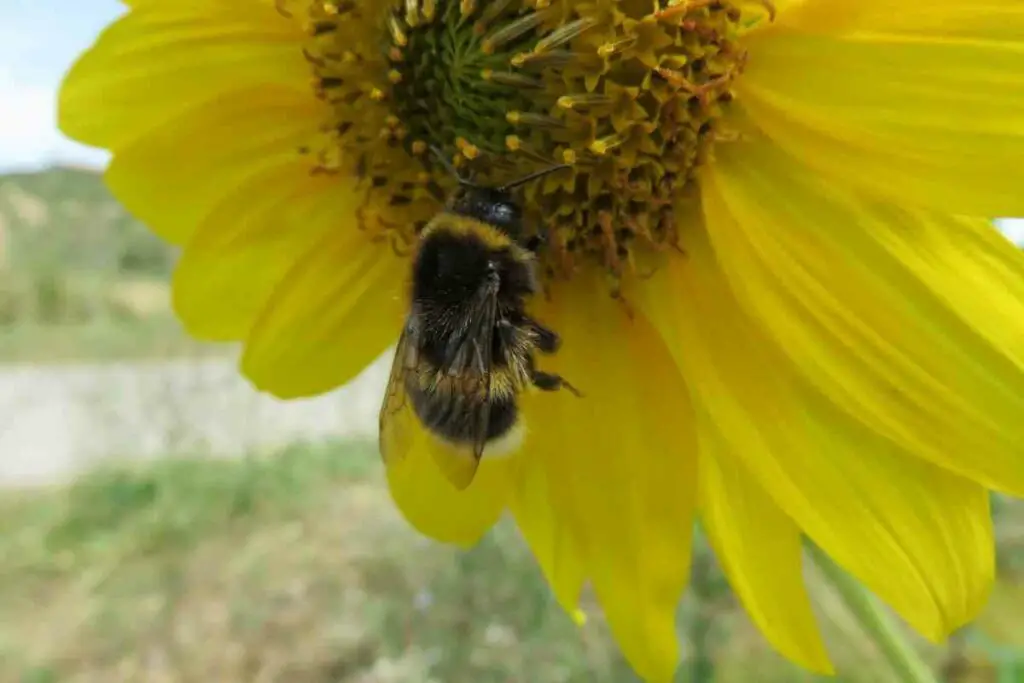
- Time active: April to October
- Size: Medium-large (up to 17mm)
- Body shape: Bombiform
Body color and pattern:
- Prominent tongue, black body with yellow collar
- Yellow bands on the thorax and upper abdomen
- White tip on tail
Additional points:
- Forages flowering plants in river valleys
- Its tongue can stretch up to 2 centimeters long
- Underground nesting in colonies of up to 100 bees
MASON BEES (Osmia – Megachillid)
There are 300+ known species of mason bee. Here are the most common types.
16. Two-coloured mason-bee – Osmia bicolor

- Time active: February through fall
- Size: Medium (12mm)
- Body shape: Megachiliform
Body color and pattern:
- Black head and thorax
- Orange fuzz on the abdomen
Additional points:
- Common in Europe and Western Asia
- The orange color is less intense in males
17. Osmia (Melanosmia)
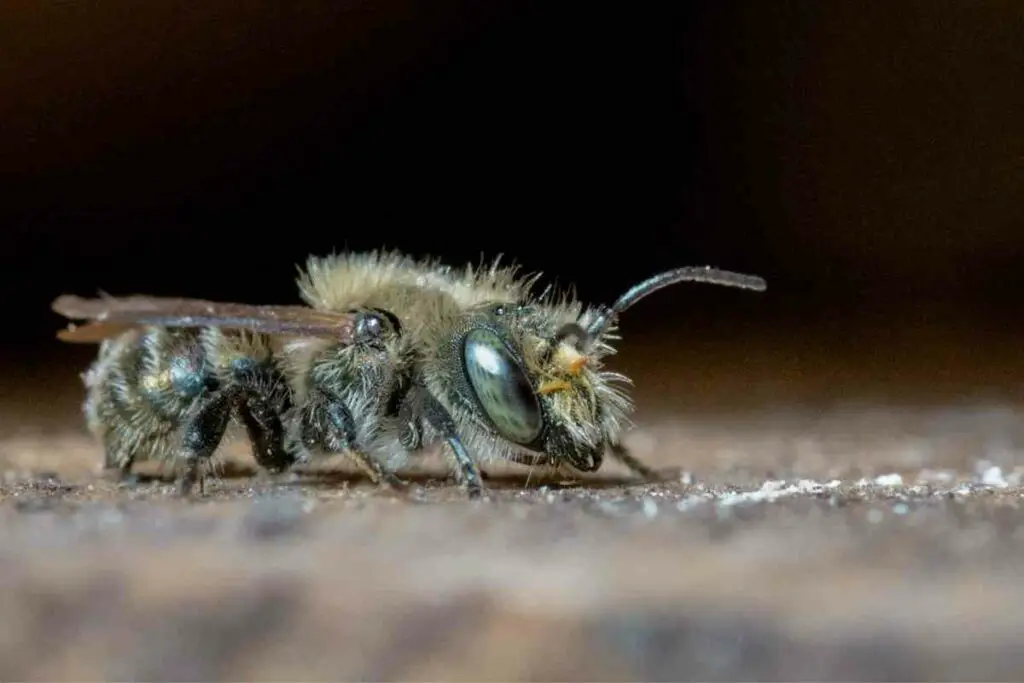
- Time active: Spring and early summer
- Size: Medium (14 mm)
- Body shape: Megachiliform
Body color and pattern:
- Black, blue, metallic blue, green, or purple
- Few hairs
Additional points:
- North America and Europe
- Solitary
- Nests in abandoned insect burrows or excavates nests in grass or rocks using mud, sand, and leaves
18. Blueberry bee – Osmia ribifloris

- Time active: Spring through fall
- Size: Medium (12 mm)
- Body shape: Megachiliform
Body color and pattern:
- Metallic blue green body with hairs on its head, thorax, and abdomen
- Hairs are black in females and black and white in males
Additional points:
- Native to the western US and Mexico
- Solitary pollen gatherer
- Pollinates blueberries
- Nests in abandoned nests and man-made structures
19. Orchard mason bee / blue orchard bee – Osmia lignaria
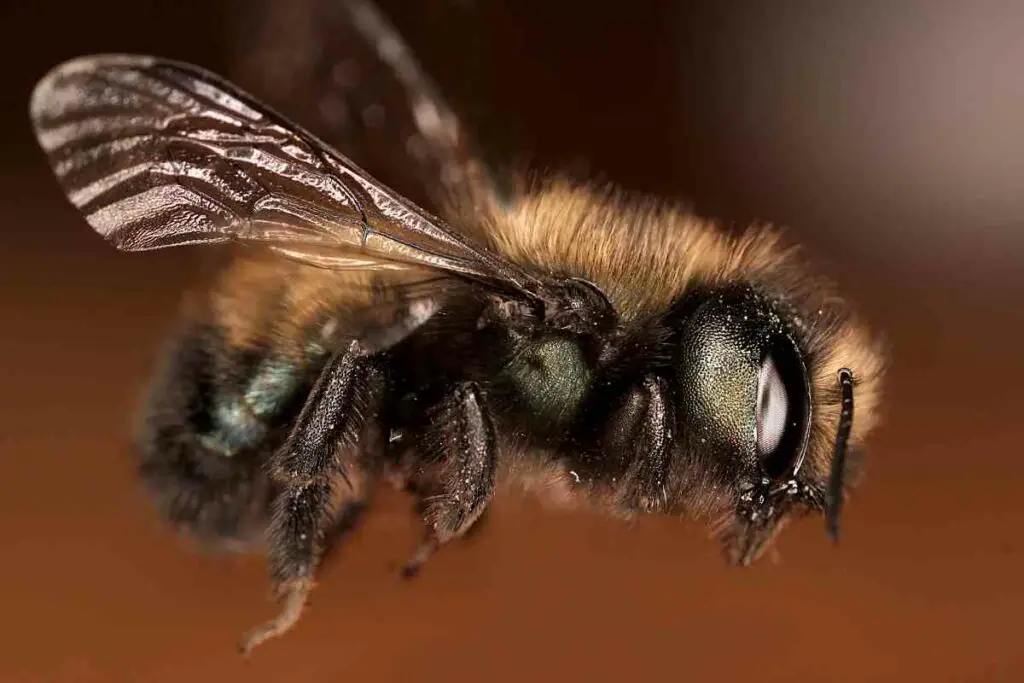
- Time active: Mid April to late June
- Size: Medium (14 mm)
- Body shape: Megachiliform
Body color and pattern:
- Dark metallic blue
Additional points:
- Native to North America
- Solitary
- Nests in narrow holes and tubes
- Active pollinator, that may be used commercially
- Bee houses or insect hotels attract these mason bees
20. Red mason bee – Osmia bicornis
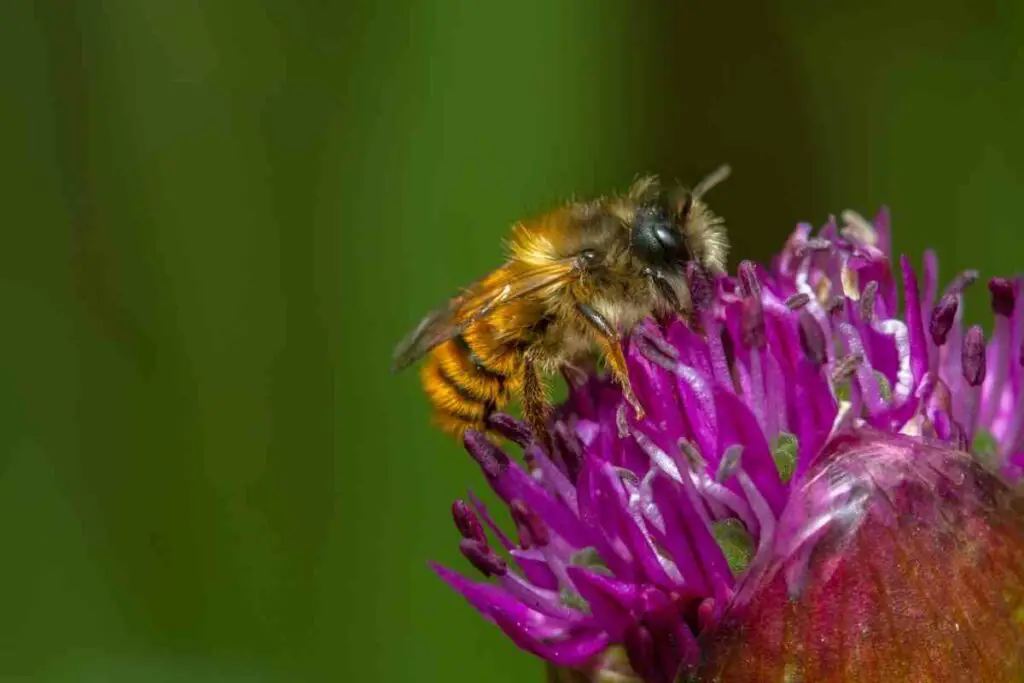
- Time active: Spring through mid-fall
- Size: Tiny (under 10 mm)
- Body shape: Megachiliform
Body color and pattern:
- Head is black
- Brown thorax and red-orange-brown abdomen
Additional points:
- Common garden visitor
- Males are smaller but similarly colored
- Females will nest in tubes, hollow plant stems, or holes and lay eggs for the next year
- Will use bug hotels
21. Osmia Californica
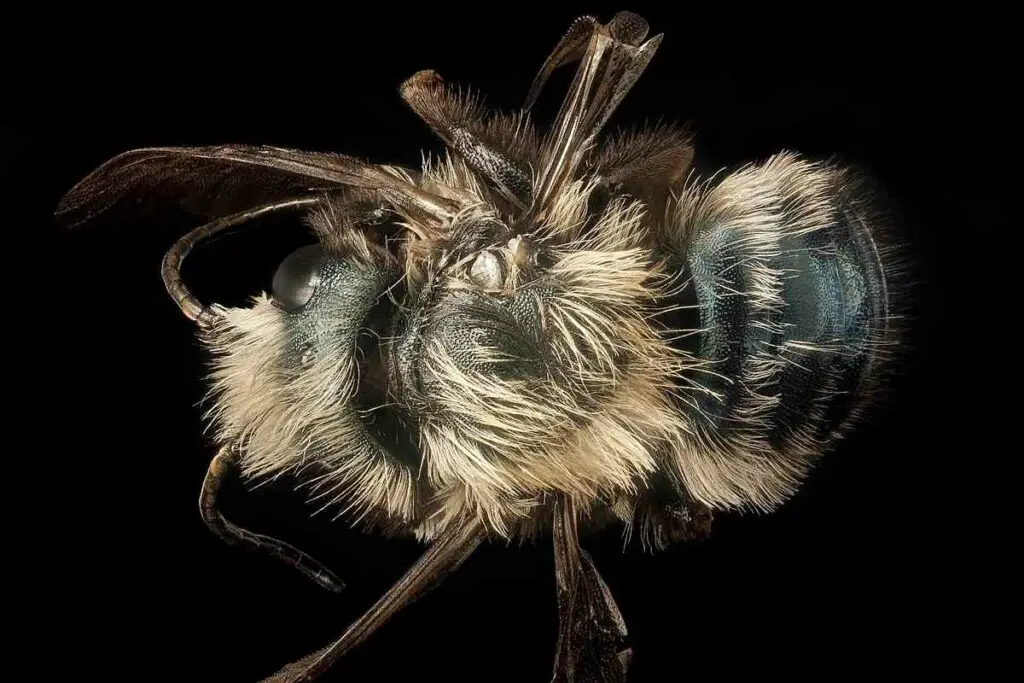
- Time active: Late spring through mid-fall
- Size: Medium (15 mm)
- Body shape: Megachiliform
Body color and pattern:
- Large stubby head
- Orange fur and dark wings
Additional points:
- Native to North America
- Solitary
- Nests in narrow holes and tubes
- Active pollinator, that may be used commercially
- Similar habitat to the orchard mason bee
CARPENTER BEES (Xylocopa)
There are 500 known species of carpenter bees. Here are the most common types.
22. Eastern carpenter bee – Xylocopa virginica
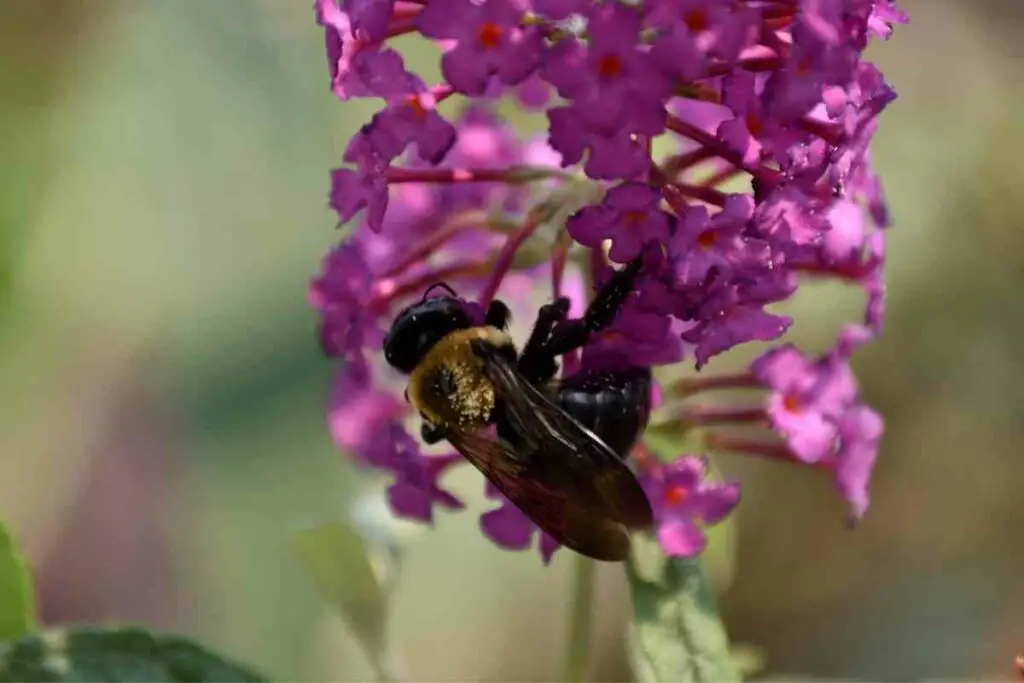
- Time active: Spring through fall
- Size: Large (up to 20 mm)
- Body shape: Large stocky body
Body color and pattern:
- Pale orange thorax, metallic black abdomen with dark wings
- Males have black faces and females have white faces
Additional points:
- Native to the Eastern US and Canada
- Able to chew and tunnel into wood
- Usually solitary bees, but if resources are limited they may nest as a group
23. Valley carpenter bee / Hawaiian carpenter bee – Xylocopa sonorina
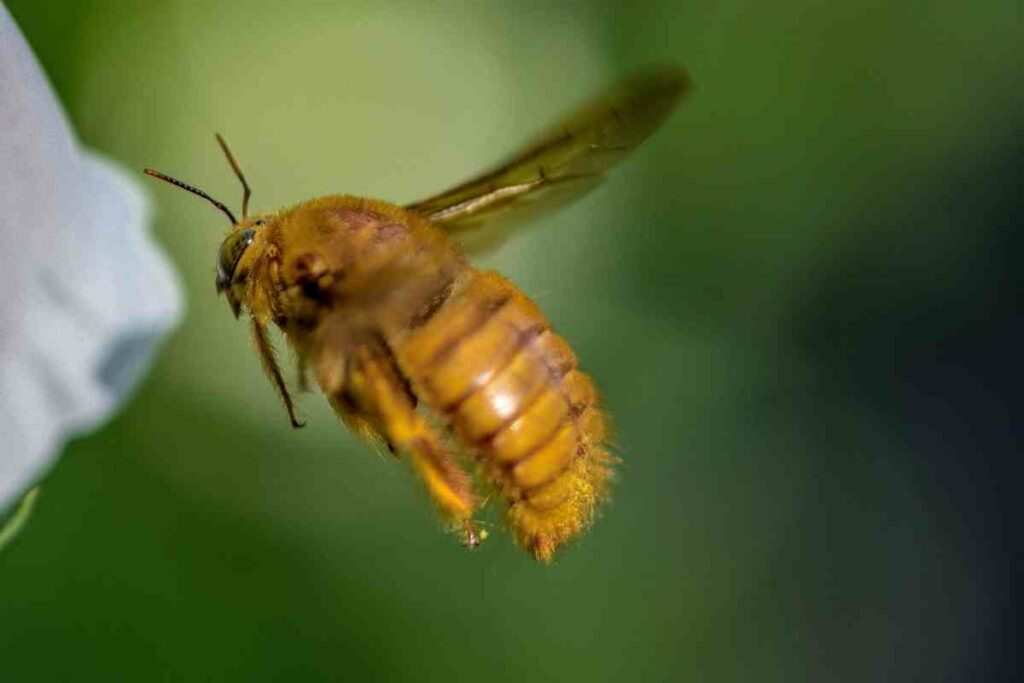
- Time active: Spring through fall
- Size: Large (up to 25 mm)
- Body shape: Large stocky body
Body color and pattern:
- Metallic, shiny black females
- Yellow furry males with green eyes
Additional points:
- Western Texas through California
- Able to chew and tunnel into wood
- Notable pollinator
24. Violet carpenter bee – Xylocopa violacea
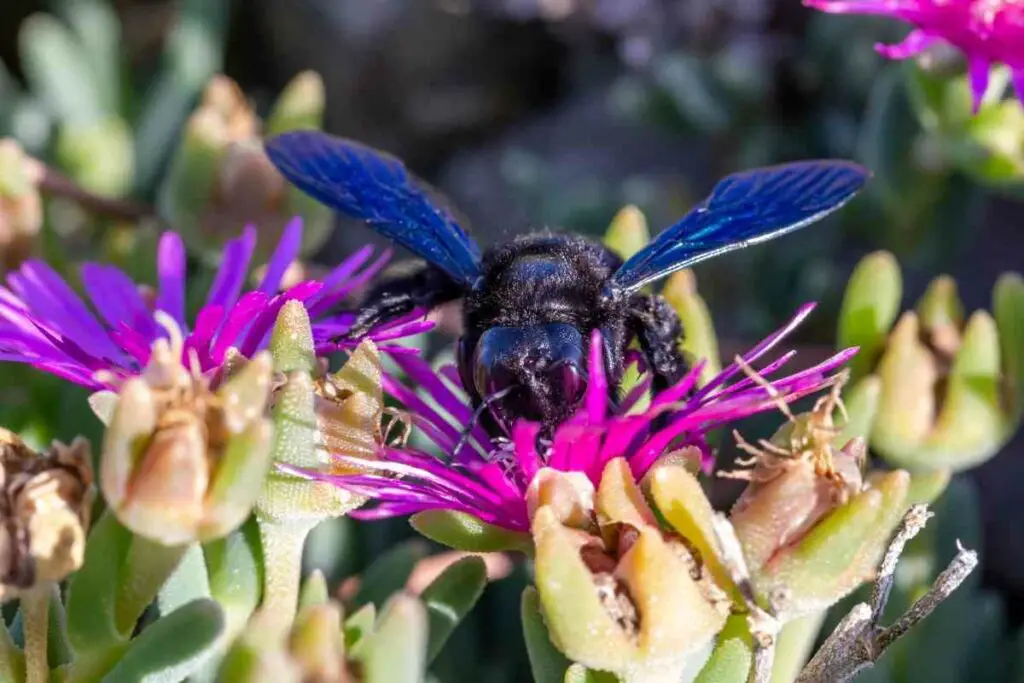
- Time active: Spring through fall
- Size: Large (up to 25 mm)
- Body shape: Large stocky body
Body color and pattern:
- Large black and fluffy bees
- Iridescent violet wings
Additional points:
- European carpenter bee
- Nests by tunneling into deadwood
- Buzzes loudly and a clumsy flyer
LEAFCUTTER BEES (Megachilidae)
There are 1500 known species of leafcutter bees. Here are the most common types.
25. Alfalfa leafcutter bee – Megachile rotundata
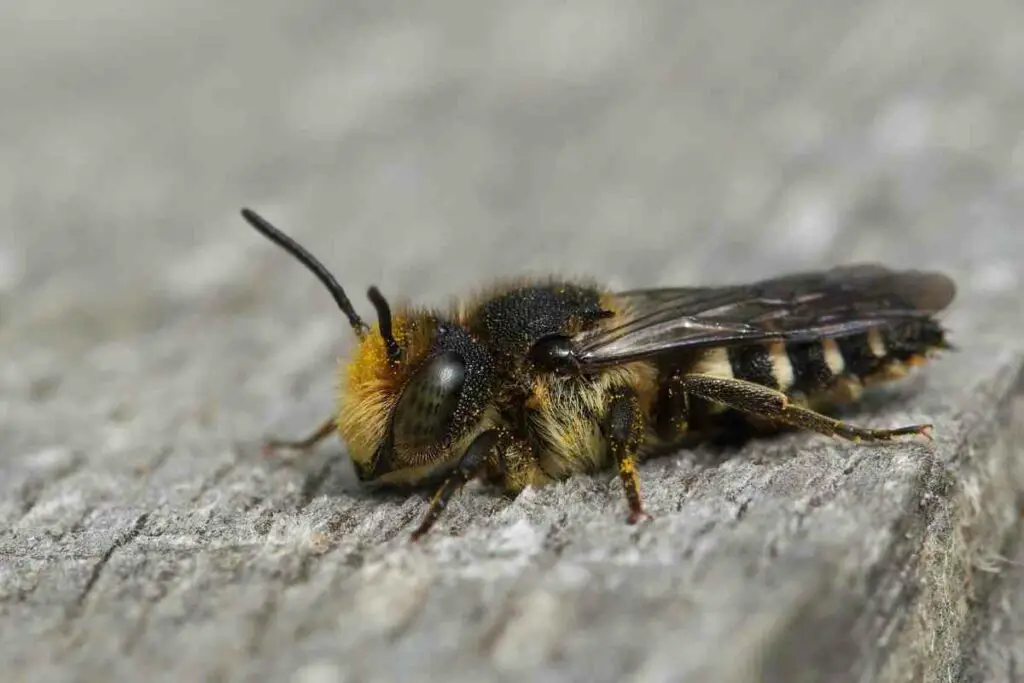
- Time active: Summer
- Size: Tiny (under 10 mm)
- Body shape: Megachiliform – slightly pointed abdomen
Body color and pattern:
- Mostly grey black with thin bands of yellow hairs on thorax and abdomen.
Additional points:
- Smallest leafcutter subspecies
- Commercial pollinator
- Native to Europe but introduced around the world for agricultural purposes
26. Wood-carving leafcutter bee – Megachile ligniseca
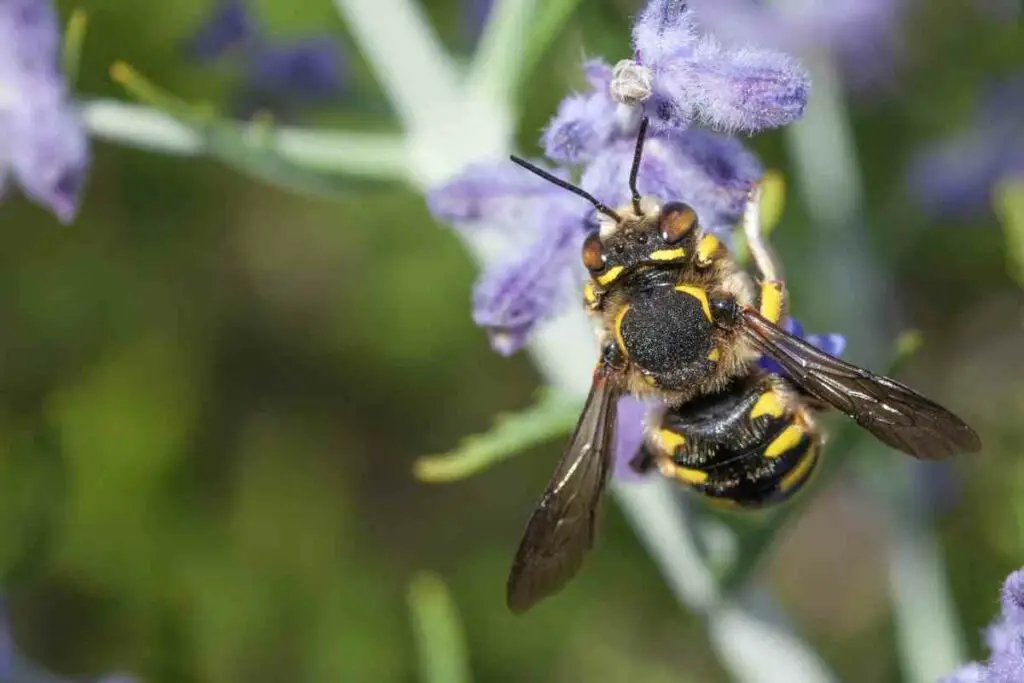
- Time active: Early June to early September
- Size: Medium (15 mm)
- Body shape: Megachiliform
Body color and pattern:
- Three tone: buff, to yellow to black or gold to red to black.
Additional points:
- Largest leafcutter subspecies
- Able to drill holes in timber
27. Coast leafcutter bee – Megachile maritima

- Time active: Late spring to summer
- Size: Medium (>10 mm)
- Body shape: Megachiliform
Body color and pattern:
- Dark brown bee with golden orange hairs
Additional points:
- Coastal areas, sand dunes and heaths
- Females and males have a similar size
Other Bee Species
28. Yellow-faced bees (Hylaeus)
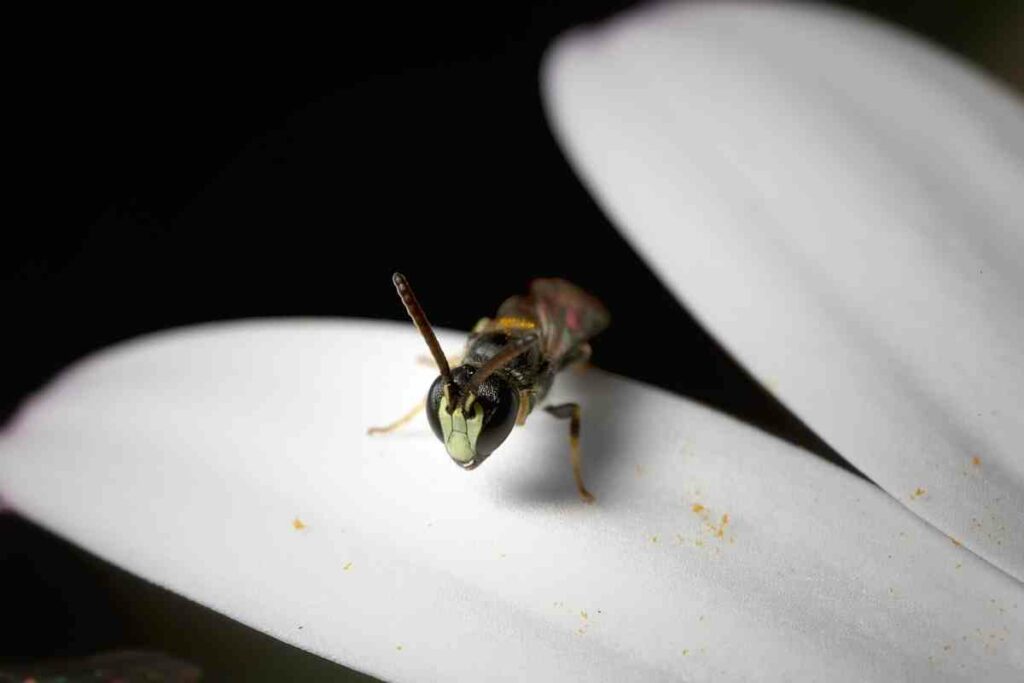
- Time active: May to September
- Size: Tiny (under 10 mm)
- Body shape: Andreniform Wasp -like body
Body color and pattern:
- Appearance similar to small wasps
- Yellow, white and black marking on the face, thorax and glistening black abdomen
- Almost completely hairless
Additional points:
- American solitary bee species that nests in tunnels
- Many subspecies are found in Hawaii
- Forages pollen and water
29. Furrow bee (Halictus)
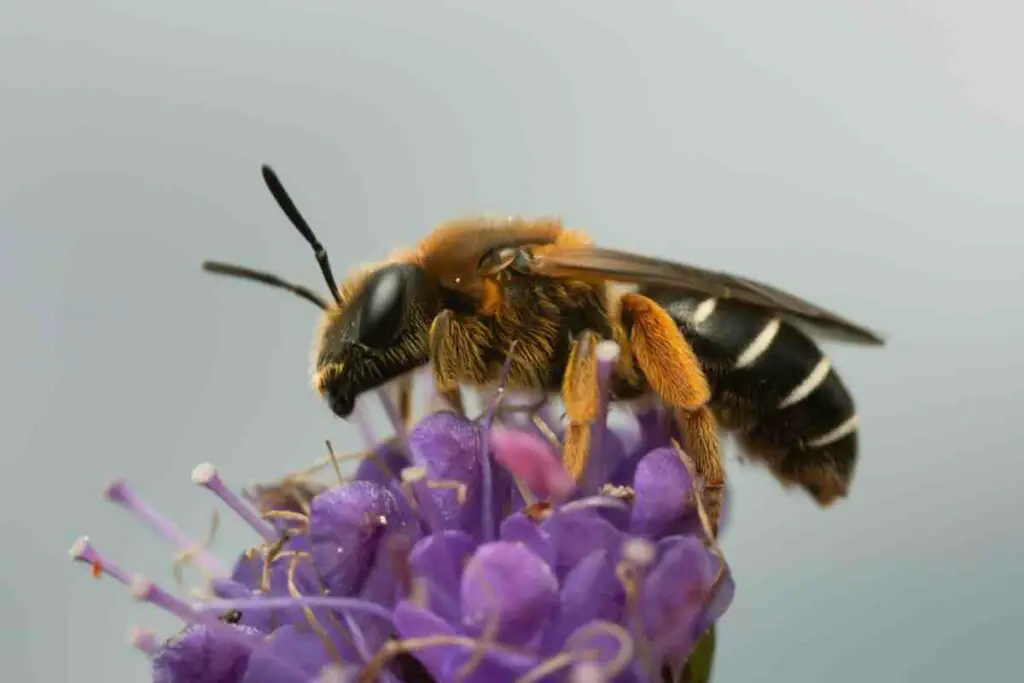
- Time active: March to October
- Size: Small (10 mm)
- Body shape: Andreniform
Body color and pattern:
- Varied appearance with colors ranging from metallic brown, green, blue, to red, orange, and purple
- Yellow faces are common
Additional points:
- Second largest bee family, over 4500 sub species
- Solitary
- Known for being attracted to perspiration (sweat bees)
- Ground and wood nesting
30. Box-headed blood bee (Sphecodes monilicornis)
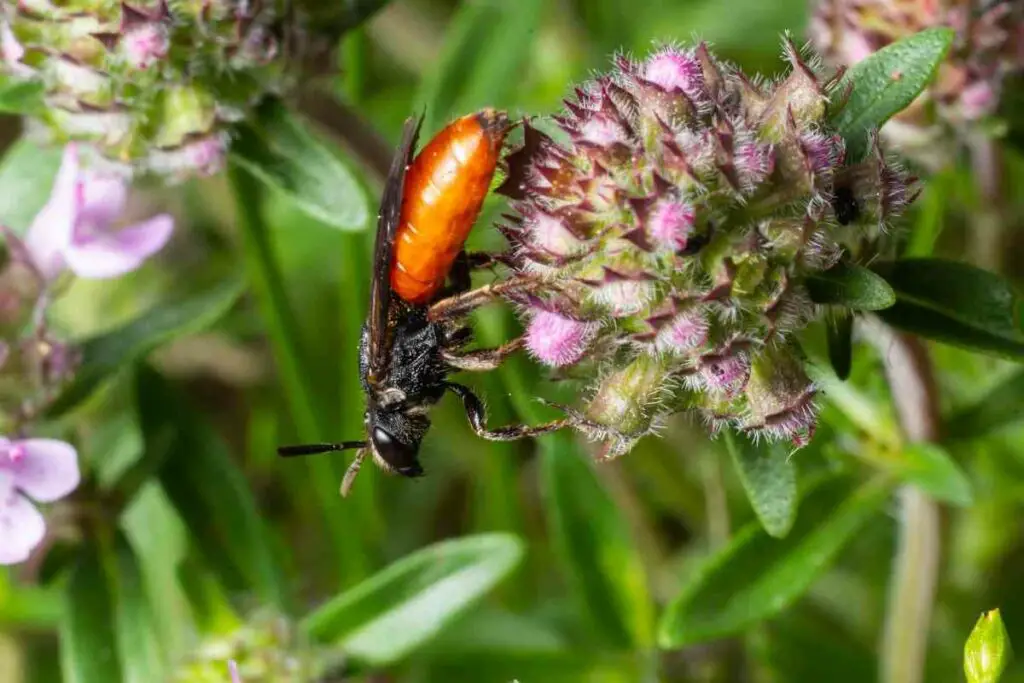
- Time active: March to September
- Size: Medium (>10 mm)
- Body shape: Thin, elongated body
Body color and pattern:
- The blood-red abdomen and box-shaped head are the most distinctive features of this bee
Additional points:
- These bees are known to forcibly invade nests, destroying eggs and larvae
- They then lay their own eggs and reseal the nest
31. Pantaloon bees (Dasypoda hirtipes)
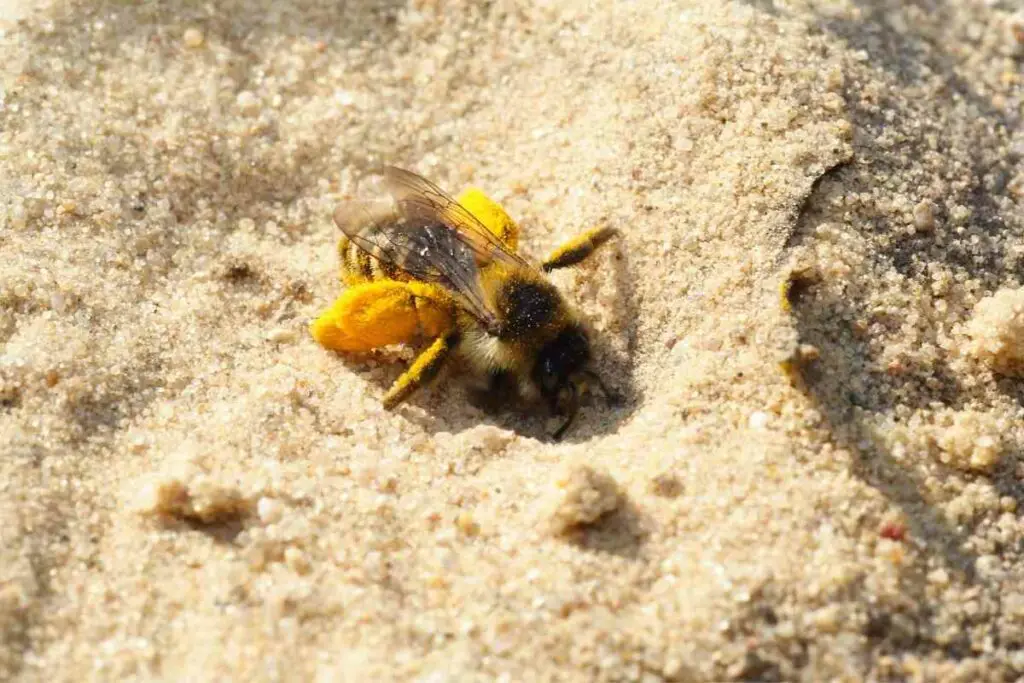
- Time active: June to late August
- Size: Medium (13 mm)
- Body shape: Andreniform
Body color and pattern:
- This bee is identified by the prominent pollen brushes on its legs, that look like pantaloons when filled with pollen
Additional points:
- Found in coastal areas, sand dunes, and heaths
- These bees dig out their nest burrows with large mandibles and use the prominent hair on their legs to brush debris away as they dig
Rounding Up
As you can see, there are so many bee species you can spot in your yard throughout the year.
If you have plants or crops, they’ll help you out by doing the essential work of pollination.
Why not make bees welcome in your backyard by providing a shallow source of water or installing a bug hotel for them to shelter in the winter months?
Anything you can do to help your local bee population will benefit everyone.


